Jordanian Site of Petra – Petra the Most Important Tourism Site in Jordan
The famous “Lost City” of Petra, remembered in poetry as “a rose-red city half as old as time,” and unforgettably featured in a host of films, novels, and video games, is one of the “Seven Wonders of the World”

Petra
Content
>Petra’s Unique Appeal
>The Story of Petra
>Seven Wonders of the World
>Planning for Petra
>Tourist Market for Petra
>The Petra Master Plan
When in January 2007 it was announced by the New 7 Wonders Foundation that Petra was one of the 21 finalists for the “New Seven Wonders of the World,” a day-long festival was held in the square in front of Petra’s famed Treasury to celebrate the event. Accepting the official certificate of candidacy, Queen Rania of Jordan gave voice to the most eloquent explanation of the meaning and greatness of Petra.
Petra is more than just an archaeological treasure. Petra…offers an enduring message to all mankind. In Petra, human beings—ordinary mortals like you and me—saw potential beauty and grandeur in walls of sheer stone. They imagined the possibility of elegance and splendour where others would see only a barren and desolate wilderness.
“The magical rose-red city of Petra is like nothing else on earth,” she said, “It is a remarkable testimony to the human spirit, etched for all time in sandstone and shale.” For the reality is, she went on to say,
“Petra is more than just an archaeological treasure. Petra…offers an enduring message to all mankind. In Petra, human beings—ordinary mortals like you and me—saw potential beauty and grandeur in walls of sheer stone. They imagined the possibility of elegance and splendour where others would see only a barren and desolate wilderness.”
Apparently millions of people all over the world agreed, for more than 100 million votes were cast around the world—over the internet and by text message, with Petra leading all the way. When the final results were announced on July 7, 2007 in Lisbon, Portugal, it became official: Petra was on the list as one of the New Seven Wonders of the World.
Petra’s Unique Appeal
Petra stands out on the list as having some very special kind of appeal—a romance, a magic, an historical meaning beyond its beauteous splendor, an inspirational dimension—unlike any other. It impresses most uniquely as a “Lost City”—a thriving metropolis of antiquity that disappeared from view more than a millennium ago, but which suddenly re-appears in magical splendor to fascinate and intrigue us in modern times. 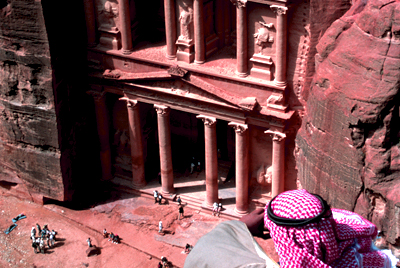
Petra is also the home of a lost people—the Nabateans—and their lost culture, of which we know almost nothing, who left for us only their spectacular sense of beauty embodied in an entire city carved of stone.
Truly, the spirit of Nabateans challenges us moderns like none other; for their having the daring to imagine, as Queen Rania says, “the possibility of elegance and splendour where others would see only a barren and desolate wilderness.”
As the modern world seems to be tottering more and more on the edge of an abyss of spreading war, economic chaos, and environmental catastrophe, what could be more hopeful or appealing than the silent message of Petra’s ruins—that of an ancient people who, in the desert, saw and created beauty where others saw only barrenness and desolation?
For, Petra speaks to us not only of history; but of, as Nasser Sharaideh, Director of the Petra Development and Tourism Regional Authority (PDTRA), “the past, the present, and the future.”
The Story of Petra
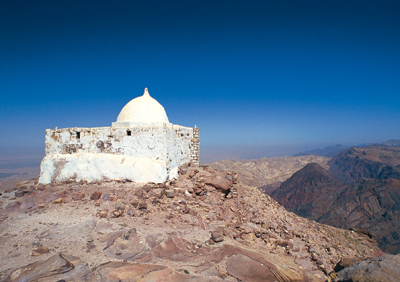 The area of present day Petra contains archeological sites indicating that the area was settled as long as 6000 years ago, and was once the home of the Edomites mentioned at several places in the Bible. According to tradition, Petra is the spot where Moses struck his staff to a rock and water gushed forth, and where Moses’ brother Aaron is buried, at Mount Hor, known today as Jabal Haroun or Mount Aaron.
The area of present day Petra contains archeological sites indicating that the area was settled as long as 6000 years ago, and was once the home of the Edomites mentioned at several places in the Bible. According to tradition, Petra is the spot where Moses struck his staff to a rock and water gushed forth, and where Moses’ brother Aaron is buried, at Mount Hor, known today as Jabal Haroun or Mount Aaron.
But its fame today rests on the arrival of the Nabateans sometime before the 6th century BC. The origins of this people is veiled in mystery. All that is known is that by the 1st century BC, their city had become the chief gathering site on numerous trade routes from India, China, and other points east that intersected there.
Their desert home was dry and parched, but the Nabateans developed the technology to harness natural springs, and store rainwater in underground vaults that sustained lush gardens and sufficient drinking water for a city of up to 20,000 at its height.
Petra is a city chiseled into the cliffs of a valley nestled in the sandstone mountains of southern Jordan, whose streets, temples, markets, forums, palaces, homes, and cemeteries sprawl along winding gullies of rock-cut carvings and free-standing structures. ![]()
It thrived for several centuries as an independent center of control over a multitude of surrounding stops along trading routes, continuing to grow its rock-hewn city, but gladly incorporating all the surrounding architectural influences from Assyrians, Egyptians, and Greeks, until the year 106 AD, when the Emperor Trajan laid claim to it, incorporating it into the Roman Empire as the province of Arabia Petraea.
Trajan also commanded the building of a Roman road from Damascus to Aquaba—the Via Traiana, or King’s Highway—which is not only still in use today, but is the most well-preserved Roman road east of Italy.
For the next two and a half centuries, Petra absorbed much of Roman architecture, building temples and coliseums, colonnaded forums and fountains, homes, and cemeteries in the Roman fashion.
When the seat of Roman power shifted to Constantinople, Petra accepted Byzantine influence. The Emperor Hadrian visited Petra in 131 AD. An arch was built in his honor, and he in turn bestowed his name on Petra as the city of Hadriana, a fact attested to by some coins of the period.
But the coming of Roman power was a mixed blessing for Petra. Roman protection meant that trade could safely take other routes, and the commercial importance of Petra declined. By the third century, Christianity came to Petra, and by the fourth it had both Byzantine churches and bishops.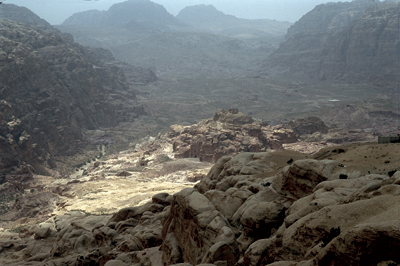
Then came a massive earthquake in 363 AD, destroying much of the city’s free-standing structures, but more importantly disrupting its complex water system. Petra might have recovered and rebuilt, but by this time its trade routes had so declined that it soon was largely deserted.
The few who remained accepted Islam in the 7th century, and the Crusaders conquered it and built a fort there—in addition to their great castle Mont Real not far away—in the 12th century.
But after Saladin drove out the Crusaders, Petra lapsed into obscurity for the next six or seven centuries, its existence known only to a few Bedouins living nearby. Then a Swiss explorer, Johan Ludwig Burckhard, rediscovered it in 1812, and wrote a book putting it back on the maps.
Indiana Jones and the Seven Wonders of the World
When the New 7Wonders Foundation of Bernard Weber was conducting its worldwide internet voting campaign to select the “New Seven Wonders of the World,” Petra was an immediate favorite: 22 million of the 100 million votes cast worldwide were for Petra over the scores of other sites contending for the honor.
It is hard for us to believe—we who are living in the ultra-fast-moving-world of the early 21st century—that, although Petra was re-discovered two centuries ago, it was only known by wordy descriptions and photographs in books read largely by scholars for most of the next century-and-two-thirds.
Of course, it was made famous in John William Burgon’s unforgettable poetic description of Petra as a “rose-red city half as old as time;” and by Lawrence of Arabia who headquartered in Petra during part of the Great Arab Revolt in the First World.
All that changed, however, when the Petra Treasury appeared in the final scene of a popular 1989 adventure film. According Antistar, a travel blogger at virtualtourist.com, the effect was immediate and electric: “When Spielberg wanted an awesome location to cause a spectacle at the end of his movie, Indiana Jones and the Last Crusade, he chose the Treasury at Petra to be the hiding place of the Holy Grail.
Ever since I saw the incredible carved buildings in that movie, I wanted to see this place. And now I have. And it was worth all the effort.”. The same story is told by countless visitors to Petra who are drawn by an irresistible curiosity to see the place featured in the film.
Of course, the magic of Petra is that it has served for scenes in many other films (such as Arabian Nights, Passion in the Desert, Mortal Kombat: Annihilation, Sinbad and the Eye of the Tiger, and Transformers: Revenge of the Fallen); music videos (such as the Sisters of Mercy’s “Dominion”); novels (such as Left Behind, Appointment with Death, The Eagle in the Sand and The Red Sea Sharks, the 19th book in The Adventures of Tintin series, and Last Act in Palmyra); and video games (such as Spy Hunter (2001), King’s Quest V, Lego Indiana Jones, and Sonic Unleashed). One might say that, though the Nabateans no longer dwell there, Petra is becoming even more densely inhabited today by modern fiction.
Thus when the New 7 Wonders Foundation of Bernard Weber was conducting its worldwide internet voting campaign to select the “New Seven Wonders of the World,” Petra was immediately recognized: 22 million of the 100 million votes cast worldwide were for Petra.
Antistar suggests a reason for the irresistible attraction Petra exerts: “There are few, if any, places in the world,” he writes, “where I believe you will be left wondering how and why quite as much as you will in Petra.” For, Petra is not only an indescribably beautiful experience, but one that confronts us with an aesthetic and maybe a metaphysical question about our own existence: namely, whether we in the modern world—and the cities we build to live in—are up the standards of beauty set by the builders of Petra.
This is what Nasser Shraideh, Director of the Petra Development and Tourism Regional Authority, means when he says that Petra confronts its visitors with not only “the past,” but also“ the present, and the future.”
Since 1989, the number of people making their way to Petra has steadily grown eight-fold (omitting significant variations for periods of war in the region, such as the two Iraq wars and Palestinian Intifadas) from 91,000 in 1988, to 802,000 in 2008 (dropping to 728,000 in 2009 due to world financial crisis). But in the first 9 months of 2010, the number of visitors to Petra has already reached 639,000, promising to match the 2008 totals again, with much more growth expected—if present rates of growth continue—in succeeding years.
Planning for Petra
Although tourism as we know it today did not begin to develop in Jordan until after the Second World War, word of the wonders of Petra had already begun to attract visitors by the 1930s. In 1934, therefore, Jordan assigned the care and management of the Petra historical sites to its Ministries of Tourism and Antiquities, which in turn established the Petra Regional Authority (PRA) in 1966 to oversee an area of 853 km2 around the area of Petra, of which 264 km2 were specifically designated as the Petra Archaeological Park (PAP). 
In 1968, the first major management plan was developed by the PRA and the PAP in cooperation with the US National Park Service.
In 1985 UNESCO registered Petra as a World Heritage Site.
Thereafter three major plans were developed in cooperation with, and under the direction of, the Ministries for Antiquities and Tourism for the protection, maintenance, and overall management of the PAP site. These included the UNESCO-Petra National Park Management Plan of 1994; the International Council on Monuments and Sites (ICOMOS) Plan of 1996; and the US National Park Service PAP Operating Plan of 2000.
In 2009, all of these were brought under the control of a single agency called the Petra Development and Tourism Regional Authority (PDTRA). The specific intent was to streamline the management of the both PAP and the Petra region under one coordinated agency.
In 2004, Jordan adopted a comprehensive National Tourism Strategy, according to which archaeological and historical tourism assumed high importance.
To carry out these plans and strategies, Jordan has created a succession of governmental agencies over the years. These have included the PRA in 1966; the Petra Region Planning Council in 1995; followed by the legislation making the PAP a new type of legal entity in 2007.
In 2009, all of these were brought under the control of a single agency called the Petra Development and Tourism Regional Authority (PDTRA). The specific intent was to streamline the management of the both PAP and the Petra region under one coordinated agency.
Along with these governmental bodies, several NGOs have been deeply involved in archaeological activities as well as the management and planning for Petra. Prominent among these are the Petra National Trust (PNT) founded in 1989; the British Institute in Amman established 1976; and the German Protestant Institute for Archaeology (GPIA) established in Amman in 1982.
Growing the Tourist Market for Petra
The first goal of the PDTRA is to increase tourism. This is a national strategic goal necessary to reduce the economy’s dependence on foreign aid. With few resources, Jordan has to capitalize on services to attract foreign exchange; tourism is Jordan’s best bet to even out its trade disadvantages. According to PDTRA Director, Nasser Shraideh,
“There is already a plan to be more aggressive in marketing Petra, combined with other interesting sites in Jordan. We are also consolidating traditional markets that we have been attracting tourists from, such as Europe and the States, as well as exploring new markets such as Latin America and the Far East.”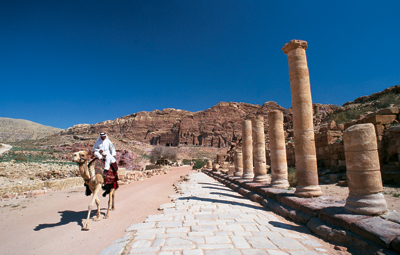
Petra is also in need of significantly more hotels—and financing to build them. According to Shraideh, “I think we need an immediate increase in room capacity here. This is a very obvious investment opportunity for many hotel chains. There is much more demand than supply, especially during March through May. But we shouldn’t stop there; I think we should move forward with investments that can challenge the tourists to come to Petra multiple times.”
The last-mentioned idea—repeating or recurring tourists—is a matter that is receiving a great deal of attention by the PDTRA: We have just “launched an exercise for a new strategic master plan,” Shraideh says, and we “hope they will come back with innovative ideas…. We are looking for a package of marketable investment opportunities that can attract more tourists for multiple times and longer periods. The site itself takes 8 full days to see entirely and 14 days to fully enjoy! But most people only stay for a couple days and their trip ends at the Treasury. ”
The PDTRA is also strategizing about broadening the scope of tourism to go beyond simply archaeological tourism (seeing the ruins of Petra), to engaging tourists in other activities, such as eco-; health-; medical-; sports-; recreational-; and perhaps even educational-tourism while at Petra.
The PDTRA is also strategizing about broadening the scope of tourism to go beyond simply archaeological tourism (seeing the ruins of Petra), to engaging tourists in other activities, such as eco-; health-; medical-; sports-; recreational-; and perhaps even educational-tourism while at Petra.
The goal is to make the tourist feel that there are many more reasons to come to Petra, many more reasons to stay longer, and many more reasons to come back again and again.
For all this to succeed, marketing is essential, and Shraideh has ambitious plans for this, too. “I believe if you have truly creative concepts that would be attractive to people with such a unique site, you can easily get there. And that is what our master plan will focus on : creating ideas that can truly attract larger numbers of tourists and help us meet our target. There is already a plan to be more aggressive in marketing Petra, combined with other interesting sites in Jordan. We are also consolidating traditional markets that we have been attracting tourists from, such as Europe and the States, as well as exploring new markets such as Latin America and the Far East.” 
The Petra Master Plan
In May of 2010, the PDTRA announced that it was working on a new 20-year Strategic Master Plan to improve all aspects of the Petra region. The prime purpose of the planning process, said Chief Commissioner Shraideh, is address all aspects of the Petra archaeological site and its surroundings in a comprehensive and long-term manner.
Chief among the concerns is to address the sensitive nature of the both the archaeological site and of the area. “The site itself needs to be well-protected and conserved for future generations, which is a challenge itself. We have been working on a long-term strategy for that.
We have to be sensitive in our development plans about threatening the site or damaging the environment. We have been trying to diagnose and analyze current and future infrastructure needs, addressing water, and energy needs. We are also trying to be more creative to address these needs, like renewable energy. The government is supportive in working with us on these issues. Roads and transport systems would be another thing to look at.”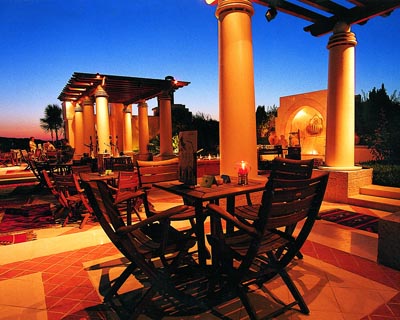
Marketing is an important part of the overall plan. Here one of the main goals is decreasing seasonality. The strategy, Shraideh says, is “to promote Petra as a tourism destination for all seasons, and change the perceptions of tourists to visit the site all year round.”
Currently, the high seasons are spring and winter. The PDTRA also announced that it had approved 6 new projects in the region. These involve expanding 3 existing hotels, and permits to begin construction on 5 new 3-star and 4-star hotels. The total of new rooms will be 560.